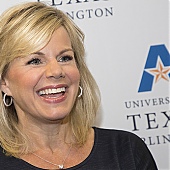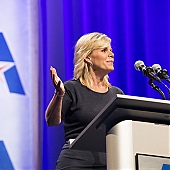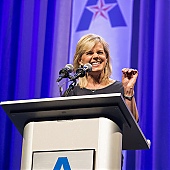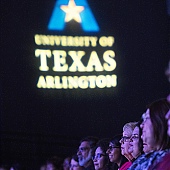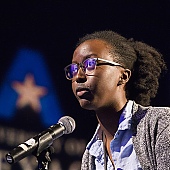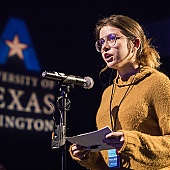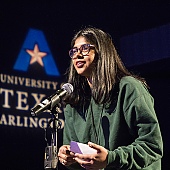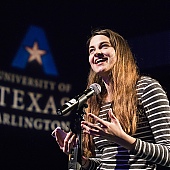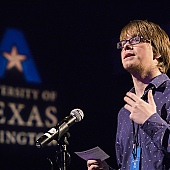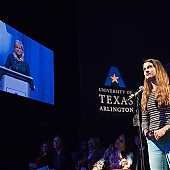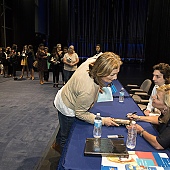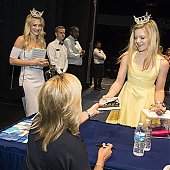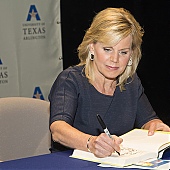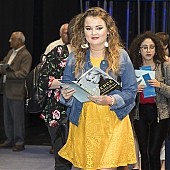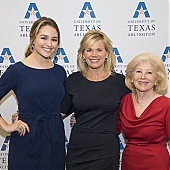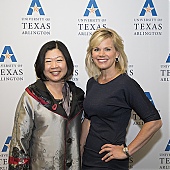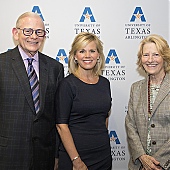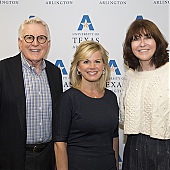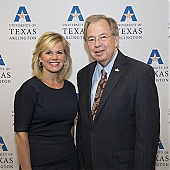Linda Ponce Campbell, 1978 Shorthorn editor, and Mark Bauer, 2010 Shorthorn editor
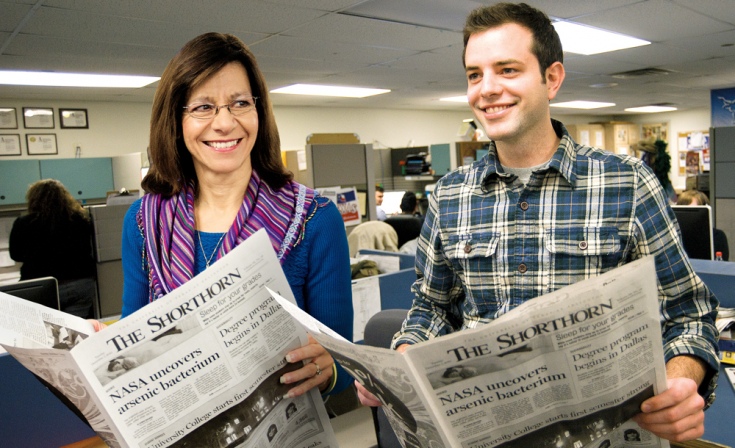
Fit to Print
Shorthorn editors have graduated to careers in law, filmmaking, acting, business, academia, and, of course, journalism. Leading the student newspaper, they say, has shaped what they've become.
· Spring 2011 · Comment ·
In the E.H. Hereford University Center basement where UT Arlington’s venerable student daily is produced—a newsroom since 1994 but before that a bar, two things that some may say really aren’t so different—there’s an office festooned with beanbag chairs, stacks of yellowing newsprint, and a commanding view of computers and cub reporters.
At various times, this office has been called, charmingly, the Fishbowl. That’s mostly because it’s dominated by glass windows. But it’s also because, like an aquarium in a doctor’s lobby, everybody watches what happens here. And what happens here matters.
Here is where the editor in chief of The Shorthorn sits. And so, here is where University news is born or buried, where ideas incubate, where young journalists are trained and summoned for accountability. Here is staged a juggling act of photos and copy and ads and headlines and bylines and deadlines.
In 92 years of publication, 135 individuals have served as Shorthorn editor in chief. I was No. 112, for one exigent semester, in fall 1997.
It’s a learning process, and what editors learn is this: Shorthorn editor in chief is simultaneously the most intimidating and most exhilarating job you can imagine. You balance college energy with journalistic integrity, Bluto Blutarsky with Ben Bradlee. And whether you do it for one semester or for half your college life, you emerge forever changed.
“It prepared me for the ‘big time’—whatever that is,” says spring 1991 editor Glen Golightly, whose big time is producing films in Los Angeles. “Being editor in chief of The Shorthorn means being ready to do anything: write, edit, fix ancient computer terminals, deal with physical or verbal threats, pat someone on the back, or kick him in the butt.”
Walt Stallings, editor in spring 1976, was to the point (and on point) when he said, “Actually, working on the paper was the fun part.”
In the same way that the boat ride is the fun part of being lost at sea.
THE PATRIARCH AND HIS PAPER
The Shorthorn’s first editor was a farm boy from Dallas named Nathaniel Killough. He was a member of the Wilsonian Literary Society, an organization focused on training cadets (UT Arlington was a military academy in those days) in debate, and he started a publication to promote the club. His journalism résumé was limited: He had paid his tuition by delivering the Dallas Dispatch.
Still, he and Herman Brautigam, who would succeed Killough at the editor’s desk, assembled 20 of their peers and produced The Grubonian in February 1919. Their publication printed only once, on two 8 1/2 x 11 pages, and was remade as The Shorthorn two months later. Killough couldn’t have imagined how his little flyer would take off.
The Shorthorn has been on campus longer than any building (Ransom Hall opened later in 1919). Among student organizations, only the ROTC is older. The paper is one of the few links shared by almost all alumni and nearly all incarnations of the University. For decades it has been rated one of America’s top college papers, and it was a charter member of the College Media Hall of Fame.
Not surprisingly, it has produced editors in chief who have earned acclaim in and out of journalism. Take Matt Stiles, editor in summer and fall 1999. He has won prestigious Katy and Houston Press Club awards, was the Houston Chronicle’s reporter of the year in 2007, and was a founding staffer for the influential upstart The Texas Tribune.
Jon Weist (fall 1981, spring 1982) is vice president in charge of governmental relations for the Arlington Chamber of Commerce. Lee Dunkelberg (fall 1974) is an award-winning voice actor, writer, and producer of documentaries and movies. Bob Dillard (spring 1975) is a former county judge and publisher of the Jeff Davis Mountain Dispatch, a weekly serving Texas’ Big Bend area.
Making headlines
Walt Stallings, Shorthorn editor in chief in spring 1976, is now senior deputy managing editor for The Dallas Morning News.
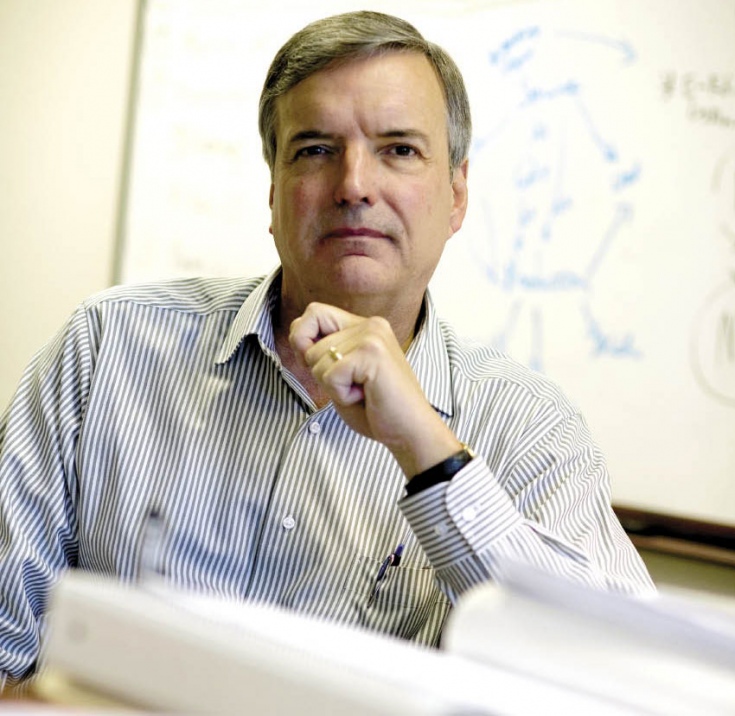
Stallings is senior deputy managing editor for The Dallas Morning News, placing him third in command in the newsroom at one of America’s largest newspapers. He says that serving as Shorthorn editor meant you knew what you would encounter if you pursued a newspaper career. “The hands-on learning was invaluable, as was the great attention to the craft of journalism taught at UT Arlington by teachers and advisers.”
“What I learned in the newsroom made me who I am as a woman, a mom, a wife, a friend, a business owner, an attorney, and a professional.”
Some education comes from the classroom. Some things take a newsroom. In the summer and fall of 1996, The Shorthorn editor was April Flanary Palmer, a ball of fire from Grand Prairie. Today she’s a defense attorney in the Texas Panhandle. She credits her time editing The Shorthorn for, well, everything.
“It’s pretty simple,” she says. “If not for The Shorthorn, I would not have gone to law school. People think I’m crazy when I say that, because it seems I’ve drifted completely away from journalism. What I learned in the newsroom made me who I am as a woman, a mom, a wife, a friend, a business owner, an attorney, and a professional.
“I learned to handle the bullies; see through the crap; face down the fear of being the only person in the room who disagrees, strongly, with the system; and be proud that I am standing alone for the guilty. Everything I do today, I am able to do with a little more confidence because of The Shorthorn.”
‘THE HARDEST CALLS’
One pivotal story—usually accompanied by a thorny decision—seems to define the tenure of almost every editor.
In 1977 Phil Latham was caught in the middle of a public feud between a fraternity and a group of student-athletes. Other controversial stories have included Student Congress debates to legalize marijuana and provide on-campus abortions, the resignation of a University president, and the dropping of football.
“The hardest calls and most difficult stories were the stories and editorials that might have played a peripheral part in ending the University’s football program,” says Theo Carracino, editor in spring 1985.
(Some things never change: “As I’m sure a lot of editors have discovered, the football thing gets stirred up once every few years,” says Jessica Freeman, editor 20 years later.)
Full circle
Now The Shorthorn’s newsroom adviser, former editor Beth Francesco, left, helps mold senior Sarah Lutz and other newspaper staffers into successful journalists.
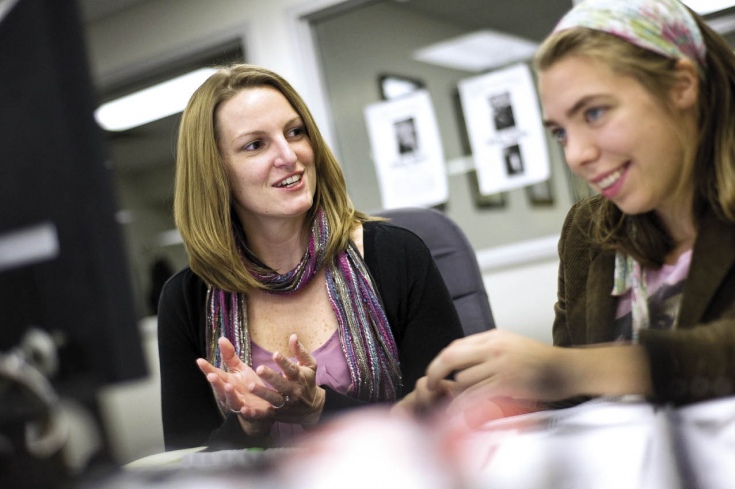
Sometimes the editor in chief’s biggest challenge isn’t what to do with a bombshell story. It’s what to do with a staff of college students focused on parties, late-night taco runs, and anything besides putting out a newspaper.
“We paid peanuts,” recalls Linda Ponce Campbell, editor in spring 1978 and now an award-winning editorial writer for the Fort Worth Star-Telegram, “but you still expected people to meet deadlines and not disappear or just sit around. The first time I had to fire someone, I learned I was not cut out for management. I could never be that George Clooney character who fired other people’s employees for a living.”
Firing an employee—a friend who was your equal a semester ago—is never easy, especially when you’re relying on a shoestring group of stringers.
“It always seemed like we were short-staffed,” says Reese Dunklin, who was editor in fall 1995 and is now an investigative reporter for The Dallas Morning News. “We worked long hours because of that. But when we would break an important story or receive positive feedback from readers, our endurance was replenished, and the momentum continued.
“After a week or semester might end, we could look back with pride at what we did. The same holds true all these years later.”
‘I UNDERSTAND WHERE YOU’RE COMING FROM’
Shorthorn editors graduate into all sorts of gigs. Some find UT Arlington a great fit. Donna Darovich, editor in 1968–1970 and 1971, became the University’s chief spokeswoman for 23 years. Heather Clampitt Levy and Trá Clough both were editor in chief in the mid-1990s and returned as faculty in the English Department. I’ve worked in the President’s Office here since 2004.
Darrell Dunn and Jason Wills aren’t on campus, but their impact is. Dunn (spring 1980, spring 1981) works for Academic Partnerships, a company that helps the University develop and deliver distance education courses. Wills (fall 1992) is senior vice president for on-campus development at American Campus Communities, an Austin-based company that has proposed building a residential complex adjacent to the campus.
Then there’s Beth Francesco. She was editor in summer and fall 2002 and spring 2003. Soon after, she became the Corpus Christi Caller-Times’ youngest-ever city editor. In 2008 she returned to The Shorthorn as newsroom adviser.
Which makes her a former editor charged with training the current one.
“Being editor in chief can be intimidating, hard work, and it’s thankless at a lot of points,” she says. “It means the world to me to help—both hands on and hands off—someone who wants to be a leader. My job is to make sure the staff, any staffer, has the tools he or she needs to be as good as he or she wants to be. I don’t think my career would have prepared me for this role had I not had the experiences I did as editor in chief.”
Mark Bauer, editor for all three semesters of 2010, says having someone who has been there, done that was an asset.
Francesco’s pride in the paper was evident, he says, and she expected the staff to keep the standards The Shorthorn is known for. “At the same time, having been a Shorthorn editor, she understood the time
restraints student editors were under. That background allowed her to speak with authority when she would say, ‘I understand where you’re coming from.’ ”
Francesco has no say in appointing the editor (that responsibility goes to a committee that considers staff members’ votes, among other things). She does, however, nurture the editor, and that’s a role she relishes.
“Once they are named editor, they realize they don’t know everything, and it can be nerve-racking—like the first day they came to work at The Shorthorn,” she says. “It’s an incredible feeling to get to remind the editors in chief that they were selected on their merit and to train them to get them comfortable with the new role. Then you get out of the way.”
‘NO TITLE EVER MEANT MORE’
Like many UT Arlington students, Shorthorn editors in chief often come from humble beginnings to achieve great successes. That’s thanks, in part, to the education they receive while working on the paper and studying in the classroom.
“UT Arlington may not be as readily known as the powerhouse journalism programs at the University of Missouri, Northwestern University, and the University of California, Berkeley,” says The Dallas Morning News’ Dunklin, a recipient of the prestigious Livingston Award recognizing outstanding young journalists. “But those programs also don’t guarantee that any student can learn better reporting and writing skills than those UT Arlington and The Shorthorn can teach its staff. I put our alumni up against the other leading journalism programs any day.”
And it’s many of these alums who will redefine journalism in 2011 and beyond. In fact, they’ve been doing it all along. The Shorthorn was among the first collegiate newspapers to go online, doing so in 1997. The Shorthorn was also ahead of other college papers (and some professional outfits) in pagination and digital photography.
What’s next for The Shorthorn and journalism in general is a great unknown. But one thing’s certain, says The Dallas Morning News’ Stallings: “It’s changing radically. But the basics of reporting and editing are still the foundation for everything. So the commitment to journalistic principles and public service needs to remain as strong as ever. Innovation and a broad range of skills will be required for anyone pursuing journalism going forward.”
In other words, at the end of the day, “credible journalism still matters.”
And so do credible journalists.
“People need good, accurate information to live their lives,” says Campbell, the Star-Telegram columnist. “You need to find ways to provide substance and credibility, not irrelevance. The future of the profession is yours to shape. Have fun.”
Fun’s never been a problem. Ask any of us. Even on those days in the Fishbowl (in its numerous configurations, as The Shorthorn offices have moved six times) when exhilarating is no match for intimidating.
“I collected a lot of titles in a working life that has somehow navigated strange waters in 54 jobs, but no title ever meant more to me or made more of a difference than that of Shorthorn editor in chief,” Carracino says. “I can’t possibly be alone in that sentiment.”
PIONEERS
FIRST EDITOR IN CHIEF Nathaniel Killough (1919)
FIRST TWO-TERM Herman Brautigam (1919–20)
FIRST WOMAN Jewel Kingrea (1920)
LONGEST SERVING Donna Darovich (1968–1970, 1971)
FIRST HISPANIC Linda Ponce Campbell (1978)
FIRST AFRICAN-AMERICAN Michael Hines (1998)
FIRST ASIAN-AMERICAN David Ok (2006)
